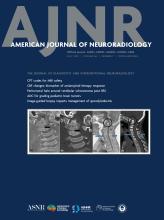Case of the Month
Section Editor: Nicholas Stence, MD
Children's Hospital Colorado, Aurora, CO
December 2013
Next Case of the Month coming January 7 . . .
Vigabatrin-Associated Transient MRI Changes
- Background and Clinical Features
- Bilateral and symmetric signal abnormalities involving the basal ganglia, thalami, and dorsal brainstem in an infant necessitate a long list of differential considerations, including ischemic, toxic/metabolic, and infectious/inflammatory causes. Correlation with ancillary imaging, clinical history, and metabolic profile is key for limiting the differential list.
- Vigabratrin-induced transient MRI signal changes represent a rare, yet important, radiological entity within the toxic subcategory. If recognized correctly, more extensive clinical work-up and/or treatment may be avoided.
- Vigabatrin is an antiepileptic drug used for treating infantile spasms. Animal studies have described vigabatrin-associated intramyelin edema after prolonged administration. Such histological changes are less well-established in humans.
- Studies in humans have documented reversible and marked MRI T2-hyperintensity and diffusion restriction in the globi pallidi, thalami, dorsal pons, and midbrain in up to 30% of infants undergoing treatment.
- In a retrospective series by Milh et al, signal changes were transient, occurring between 1 to 12 months after initiating therapy. Maximal signal intensity occurred at 3 to 6 months with normalization after 12 months.
- Affected children are less than two years old, and risk is related to younger age and higher dose, implying susceptibility of the developing brain; similar signal changes have not been described in adults treated with vigabatrin.
- Key Diagnostic Features: Bilateral, symmetric, and marked T2 hyperintensity and diffusion restriction in the globi pallidi, thalami, dorsal pons, and midbrain in an infant on vigabatrin therapy. No associated enhancement, T1 signal changes, hemorrhage, or venous/arterial thrombosis. MR spectroscopy has a normal profile with absence of lactate or lipid peak.
- DDx: Venous sinus thrombosis, postictal ischemia, hypoxic-ischemic injury, Leigh disease, mitochondrial disorder (MELAS)
- Rx: Vigabatrin-associated MRI signal changes appear to be transient and unrelated to the epileptic syndrome, EEG patterns, or seizing activity. It is unclear whether MRI signal changes represent true toxicity warranting discontinuation of treatment. Clinical signs of vigabatrin toxicity may be more appropriate for guiding therapy.











